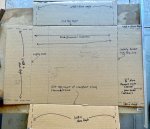Wrathchild
Active member
@aaaslayer congats on the new camper! Cool to see the changes and upgrades they’ve made since I got mine.
Yeah -- I really like the look of Jay's new solid cabover with a contrasting color. Much nicer. I really wanted to do that, but went with the extra height instead so I could sit up in bed. The penalty of being tall . . .Cool to see the changes and upgrades they’ve made
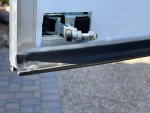
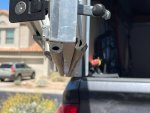


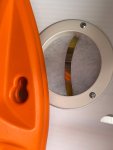
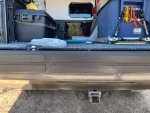
Love that positive pressure vent! Thanks for sharingYeah -- I really like the look of Jay's new solid cabover with a contrasting color. Much nicer. I really wanted to do that, but went with the extra height instead so I could sit up in bed. The penalty of being tall . . .
Since dust is a current topic, I'll continue my build posts with a couple of things I did not mentioned so far. First, this stuff is really great, if you haven't used it.
Amazon product ASIN B00IPQWXZQ
It's not just for tailgates! I think I've bought at least three of these. BTW, I'll show links sometimes, but I have no affiliation and don't make money on any of them.
Jay's bulb sealing on the barn doors and windoors is very good, but not perfect. If you want dust free, gotta add some. I used the ESI tailgate seal in several places, especially the barndoor/tailgate cap border (and of course the tailgate). The outer seal is Jay's, the inner one is added.
View attachment 699496
View attachment 699497
I still got a bit of dust under the doors when I was blowing the back off with the compressor, so I added this:
View attachment 699498
The ESI adhesive is really good, but it didn't hold that well on my tailgate cap initially after a few uses, so I put a new one on and used this:
Amazon product ASIN B07K1TRBRY
It's for VHB tape on what 3M calls low energy surfaces (basically not metal or glass). I've used it a lot and it really works for a nearly permanent bond. Works great on the ESI seal adhesive.
The hatches/windoor seals are fine, but after a year, I've tightened up the clamp arm (?) on latches (not sure what to call it, but you can see it in the first picture of this post on the back of the barn door) to eliminate a very small gap.
The other thing I did that I think has really helped get to nearly zero dust is a positive pressure vent (PPV). Here's the outside:
View attachment 699500
and the inside:
View attachment 699501
Because our campers are big square blocks in the back, they create a lot of aerodynamic drag and and backdraft that showers the back doors in dust. With any speed (>10mph) on long dusty roads we are also creating low pressure inside the camper that sucks dust through any gap. The PPV allows clean(ish) air to be sucked/blown in from the front and stops the vacuum effect, including when we get on the highway after being offroad. Driving at high speeds further sucks in the dust without some equalization.
The PPV is a marine vent for boat hatch covers.
https://www.westmarine.com/buy/lewmar--cabin-hatch-vent-trim-kit--P024_720_004_502?pCode=2678175
I talked to Jay about this and he had me bring it up and installed it when my camper went on the truck. It's a simple install -- 3" hole saw and four screws to fasten the inner section through the wall to the outer vent with a bead of sealant. This is completely waterproof and has a O-ring plunger type closure from the inside. I just added some inch thick dacron aquarium filter material I had hanging around and found some spring steel strips to hold it in. Stays very clean and breathes well.
Here's an example after 25 miles of offroad. You can see where the dust stops, and this is before I beefed up the tailgate to barndoor seal. I'm always in totally dusty conditions and it's really been worth it for me. YMMV.
View attachment 699510
Next post -- electrical . . .
I wound up using black silicone. I used gorilla tape and put a layer of silicone over it. Very few holes have gorilla tape though.Jay suggested using Butyl bead/tape to me. We used 1/4“ bought off Amazon. Worked really great to plug holes. doesn't fully harden (and crack), is tenacious and stands up to heat and cold well, but can get softer with heat. Can be peeled off easier than caulk if needed. Not a caulk substitute, not for weather exposure, but better for big hidden holes and irregular shapes. Our roof seams are sealed with this, plus an external sealing of 3m magic caulk of some sort. You knead it it and shape it by hand.
I used Gorilla tape on my Tacoma and regretted it. Doesn’t handle heat well and migrates, leaving a god-awful residue. Try Gaffer tape over Butyl bead stuffed in the hole. Works well.
That’ll work great. I‘ve had the Gorilla tape work well on clean metal. The migration problem seemed mostly to occur on plastic surfaces.I wound up using black silicone. I used gorilla tape and put a layer of silicone over it. Very few holes have gorilla tape though.

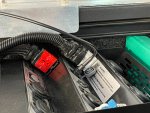
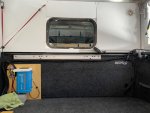
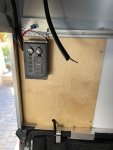
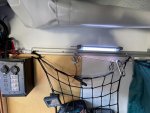
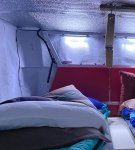



I was thinking of doing 2 boards back to back of 1/2" so I have aluminum facing on both sides. What is everyone doing? Single faced? Double?
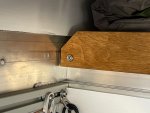

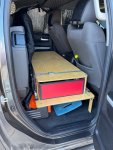
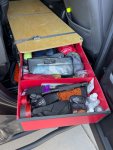
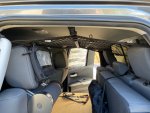
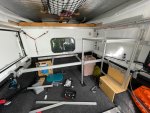
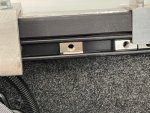


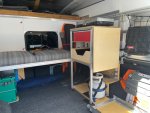
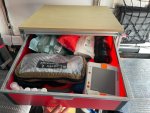
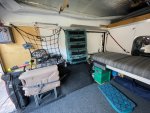
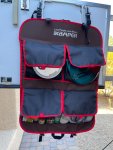



OK, now the camper built-ins.
After dust sealing the truck bed, the two things I did before getting the camper and putting in the Bedrug that I was really glad to have done first were:
1-- Take pictures of the naked truck bed with measurements for where the ridges, flat spots, bed bolts and other features were. This has been super helpful as I've added things and needed to know where to anchor them and where flat spots, etc were. Don't forget interior bedsides too. Of course, if you're not doing a Bedrug or are laying a baseplate over, never mind . . .
2-- Fitted the fridge slide and drilled holes in my truck bed to through bolt it, as well as rivnut and VHB'd short pieces of L-track to spots on the bedside where I planned to have some cam straps terminate (Rollercams -- really great product. Holds way better than others I've used). I also VHB'd a couple of 12" long, 1/2" single lot 8020 pieces to the floor in front of the wheel wells. All this was covered with the Bedrug, but then easily accessible through slots and very useful later. Bedrugs, BTW are tough to cut through, though no problem, and you end up making some big flaps. You can add rivnuts or VHB that way, but if you can plan out anchor points, etc its just a LOT easier.
I knew I wanted a shelf/bench across full the bed width that allowed the full 78 inches of bed length to be used. Most builds I had researched built a free-standing structure with legs, put it in place and stabilized it against the bedwall or bedrail. I decided to make a hanging bench from the Toyota bedrail system (which I added). It's rated for 800lbs, kept the build light, and could be made pretty stout with 8020. I purposely avoiding tying any structure to the camper. It's quite rigid, but the Tundra beds flex, as do most truck beds, though the Tundras flex more. Having structures anchored to both is a bad combo off road. Even with bed stiffeners.
We purposely keep the P-side corner of the bench and cabinet open for storing tall vertical things -- full sized Maxxtrax, shovel, camp chairs, etc.
View attachment 700295
I bought the all the extrusions and hardware from Tnutz, not 8020. 8020's website and catalog are great for research, but their prices and wait times (this was Aug/Sept '21) are ridiculous. Tnutz has a more limited, but still great selection, they are a 1/3 to half the price, the extrusions are the same and they were shipping within 2 weeks or less vs 80 to 90 days from 8020.
I went with 10 series extrusion and standardized all hardware to 1/4-20. Many people will say use 15 series, but I've worked with it and it's unnecessarily heavy and expensive.
For the attachment ledger strips to the Toyota bedrail system, I used 1"x 2" 10 series and on the D-side 1"x3". For two reasons:
1-- I trialed a scrap piece of 1" and it was just barely too narrow to securely bridge the Toyota bed rail width and would slip under pressure.
2 -- My 1"north/south crossbars could be held with a gusset on each side AND one underneath in the second or 3rd slot. They easily hold the combined 300lbs of me and my wife on the bench
The front rail of the bench that stretches completely across the bed is 1x2" as it has a long unsupported span. 8020 has a great deflection calculator that you can model stuff like that with.
I decided to keep the plywood "step" over the P-side wheel well as it's very stout and I could avoid legs.
View attachment 700306
Got these bed rail nuts on Amazon. Bomber! 3/8" tapped stainless. Had to shim them up for my ledger rails with 1/8" aluminum bar. I used Grade 8 bolts in holes drilled through the extrusion. It's all very stout, no deflection and still pretty lightweight. ALL of the extrusion and hardware from Tnutz was 40lbs (I weighed the package) and that included 18' of additional extrusion for another project Plus, I cut a lot down (using a table saw). I estimate the weight of 8020 in the project was about 30lbs, plus the plywood, which weighs 43lbs for a 5x5 12mm sheet. I used a sheet and a half. So all told about 90-ish lbs.
I've worked with 8020 before (rack system), but never something complicated. This wasn't hard, but took a lot of planning and multiple revisions on paper. The time spent ahead is worth it, as well as living with a minimal build for a few trips to figure out what we really wanted.
Also, either a chop saw or table saw is critical if you're going to custom fit pieces as you go (I did for several reason). A drill press or drill stand is also super helpful if you're drilling though the extrusion. It tends to catch a hand drill for larger holes.
Made the bench top liftable to access the battery.
View attachment 700313
Here's the final finished product
View attachment 700314
View attachment 700316
View attachment 700317
Made the counter extension a flip up so the heater is still usable where it is. We also found it's very handy to have a surface reachable from the pulled out bed, sort of like a night table. Also put a very low shelf for the propane to allow my slide out tailgate cooking counter to fit under. Used a large quick fist with a 1" ratchet strap laced through the quick fist.
The middle compartment has 1/4" baltic birch cutouts slid into the 8020 slots with a liner from my wife's unused yoga mat. I made another coroplast drawer, using an even easier technique. The stove is sitting on top of the counter since that's where we store it strapped down while traveling.
Here's the pack bag I mention we put under the rear seat platform. We love this thing. Holds a ton, very organized. It's like a lightweight chest of drawers. Hangs from the camper bedrail. Also, you can see where I move a water jug for gravity feed water. The spigot hose isn't attached. Works great. If it's freezing no pump or plumbing to worry about. I also use a Rollercam strap vertically to hold the jug to the platform. I can leave the hose/spigot attached and it's solid enough to bounce around offroad and off camber.
I should also say the bench cushions were custom cut 3" medium firm foam from https://www.foamorder.com/ with a Dacron wrap. We got the sunbrella fabric from https://www.sailrite.com/ (great DIY resource). It's super durable. Very easy to cover your own cushions IF you use a solid base so you wrap the fabric around and staple the bottoms. No sewing!
If we need to stealth camp or close down the top, my wife can sleep on the bench and I can sleep north/south under with my Thermarest. Our goal with this was NOT to have it built out inside like a FWC, but to be able to retreat inside as needed for a day or two. Mostly it's tailgating for us, sitting outside, and retreating in for bed. That said, the bench is comfortable seating with a pillow behind us, and there's enough room with the top down to clear my head, so I'm sure we'll hang out inside more than we think.
View attachment 700322
One last organizational issue is the kitchen.
View attachment 700329
This lives on the inside D-side barn door that's reinforced. You can see it stowed in my electricals post. This is ALL of our kitchen stuff. Saw it on iKamper's website, and hoped it would work. The pockets surprised us with the roominess. Holds our pot set, dishes two Yeti mugs, a GSI skillet plus everything else. Eliminates need for more storage construction and super handy.
I'll post a little more I'm sure on odds n' ends, but that's the bulk of it. I left out some details, sources, links, etc so as not to hog this thread (at least too much!). Happy to answer questions or provide more info. Just ask.
We're going somewhere in about 3 weeks (still figuring where). I'm going to try to force myself to get it weighed again fully loaded, and I'll post that if I do.
Good luck on your builds!
nice build, there is a dedicated thread to all pop tops. This thread is OVRLND CAMPERS specific only for those who have OVLRND CAMPERS brand pop tops.My current build is a Hallmark Brand Ford Bronco Specific Pop-Top Camper I am transferring from my Tan 1982 2 Door Bronco to my 1990 Centurion 4 Door 1 Ton Diesel Bronco.
Will be complete this spring.
Very definitely, though if you use 1/4" (really 5mm) baltic birch plywood that's pretty light too and def stronger. Coroplast will give you rigidity along the flute/chanel lines, but can be flexible. If you anchor the walls on the side it would be pretty impact forgiving. It's just much easier, cheaper and quicker to work with. No sawing, dust, sealing, finishing, etc. I'm using 4mm but there is a stronger, still light 6mm available, but not at Home Depot.But I imagine sheathing with coroplast is much lighter?
Thanks! Not sure exactly how you mean "sheathing" WRT the drawer, but just to be clear, the drawers are actually completely made of coroplast, but with some corner and edge reinforcement which actually can be optional. There's no inside frame. The strength comes from the folding. Don't have construction process pictures, but I was garage cleaning this morning and found my cardboard drawer template so I marked it up quickly:Great idea on coroplast sheathing your drawers
